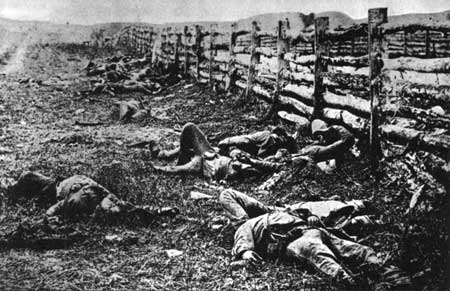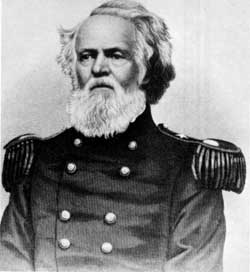|
ANTIETAM National Military Site |
 |

Taken back of the picket-and-rail fence on the Hagerstown Pike,
where Jackson's men attempted to rally in the face of Hooker's charge.
From photograph by Alexander Gardner. Courtesy, National Archives.
Mansfield Renews the Attack
As the remnants of Hooker's command sought shelter under the cover of powerful Federal batteries in front of East Woods, a new threat faced the Confederates. Mansfield's XII Corps, which had encamped more than a mile to the rear of Hooker during the night, had marched at the sound of Hooker's opening guns. At 7:30 a.m., almost an hour and a half later, Mansfield's force was approaching from the north in heavy columns.
Seeing Hooker's plight, Mansfield now rushed to the forefront of his men, urging them to the attack. But his work was cut short by a Confederate ball; mortally wounded, he was carried from the field.
Without pause, Brig. Gen. Alpheus Williams moved up to command and the attack swept on over ground just vacated by Hooker. On the right, Brig. Gen. Samuel Crawford's division bore down the Hagerstown Pike toward the Confederates in West Woods. Attacking in separate units, however, their lines were shattered by Brig. Gen. J. R. Jones' men, fighting from the cover of projecting rocks. J. E. B. Stuart's artillery, from the hill a half mile to the west, rapidly dispersed the remnants.
On the left, the Federals fared better. They pounded Hood's men back across the fields toward the Dunkard Church and opened a great gap in the Confederate line. Into the hole plunged Brig. Gen. George S. Greene's Union division. Only a desperate Confederate stand stopped Greene's men at the Dunkard Church. There they remained, an isolated salient beyond support—the Federal assault had shot its bolt.
Attacking separately, the two corps of Hooker and Mansfield had each come within a hair of breaking Jackson's line. What if they had attacked together? Again and again through this long day, the same question—changing only the names—would apply.

Maj. Gen. Joseph Mansfield.
Courtesy, Library of Congress.
It may have been while observing this critical fight near the Dunkard Church, that General Lee saw a straggler heading back toward camp lugging a pig that he had killed. With disaster so close, and straggling one of its chief causes, Lee momentarily lost control and ordered Jackson to shoot the man as an example to the army. Instead, Jackson gave the culprit a musket and placed him where action was hottest for the rest of the day. He came through unscathed and was afterward known as the man who had lost his pig but saved his bacon.

|

|
|
Last Modified: Mon, Mar 4 2002 10:00:00 pm PDT |


